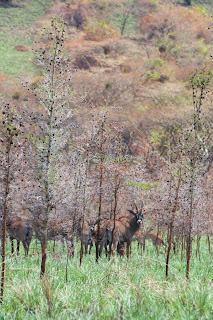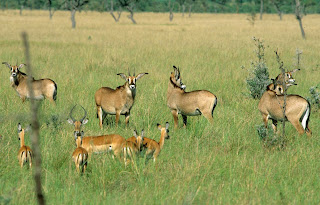Roan Antelope. Korongo in Swahili.
One of Kenya’s rarest antelopes and the third largest of Kenya’s antelopes. A large horse like antelope with a grey to rufous coat and a distinctive a black-and-white clown-like facemask, which is darker in males than females. It has long, tasseled ears.
Named for its roan color (a reddish-brown), it has a lighter underbelly, white eyebrows and cheeks, and black face. It has short, erect manes, a very light beard, and prominent red nostrils.
Both males and females have ringed backward-curving, scimitar like horns, although they are shorter in the females.
Once a widely distributed species in Kenya, the roan antelope numbers are on the decline. According to KWS official 2021 Census report, there are currently just 14 roan antelopes in the country. All the 14 are found in Ruma National Park, located in the former Lambwe Valley in Homa Bay County. This is a huge decline in the number of roan antelopes, from 202 in 1976 to 14 in 2021.
This massive decline in numbers can be attributed to killing of the Roan for meat and traditional values – such as horns for musical instruments and skin for burial ceremonies. Predation of young roan antelopes by hyaenas and pythons is also a major cause of this decline. After giving birth, the mothers keep the young roan away from herd for six weeks, exposing them to predators.
The small number of the roans within the park has already resulted in high levels of inbreeding, which most likely increase the roan’s vulnerability to diseases, stress and reduce their fertility, growth rate and survival.
Roan antelopes are similar in appearance to the Sable antelope and can be confused where their ranges overlap. Sable antelope males, however, are notably darker and have a brownish-black coat.
Scientifically, Roan Antelope is known as Hippotragus equinus. 'Equinus' comes from the Latin word 'equus' ('horse-like'), referring to its horse-like appearance.
Roan antelopes have an unusual call that sounds like a whistle. However, when they are angry they emit a high-pitched squeal, a horse like snort if scared, and a low hiss if they are wounded.
Roans congregate in herds of up to 20 individuals with a very characteristic social structure. Within the group, the more dominant female is the leader. There is only one adult male (called a bull) in each herd. The juvenile males are exiled from the herd at about 3 years old.
All the female calves remain. When the herd gets too large, it divides into smaller groups of cows and their young. These groups will form new herds, once again with only one adult bull.
The young males, which have been separated from the herd, associate in "bachelor groups" of up to 12 individuals. Among the bachelors, the most dominant will be the first individual to join a new group of females when the position is open. Sometimes, during their fights for dominancy, they inflict bodily harm to the contender.
Roan antelope are brave animals. If threatened by a predator, including lions, they will confront it, using their scimitar-shaped horns. Many of these big cats have died during such fights.




